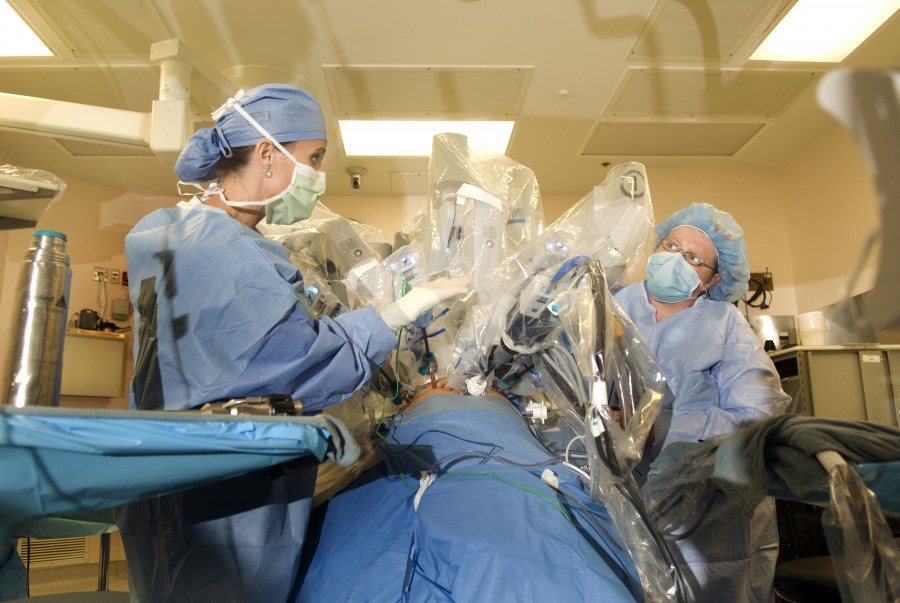
Surgical technicians Stacey Gregson, left, and Rhonda Finerty assist during a robotic surgery procedure to treat prostate cancer. (photo by Susan Urmy)
VU’s lead in robotic surgery keeps growing
A 68-year-old male with advanced prostate cancer lies on the operating table. A 1,500-pound contraption looms over him, its metal arms extend like tentacles into tiny holes in his abdomen.
The surgeon sits at the far side of the room, face pressed into a large console, hands and feet manipulating controls. As the surgeon moves, so do the tentacle arms, deftly cutting the tissue, removing the cancer and sewing the patient whole again.
This is not a sci-fi movie. This is robotic surgery that happens every day at Vanderbilt University Medical Center.
Since the first robotic prostatectomy was performed seven years ago, VUMC has established itself as a leader in robotic surgery with procedures ranging from uterine fibroid removal to gastric bypass.
The principal device for robotic surgery is the da Vinci Surgical System, manufactured by Intuitive Surgical. Vanderbilt has four of these $1-million-plus machines and the vast majority of robotic procedures are performed with them.
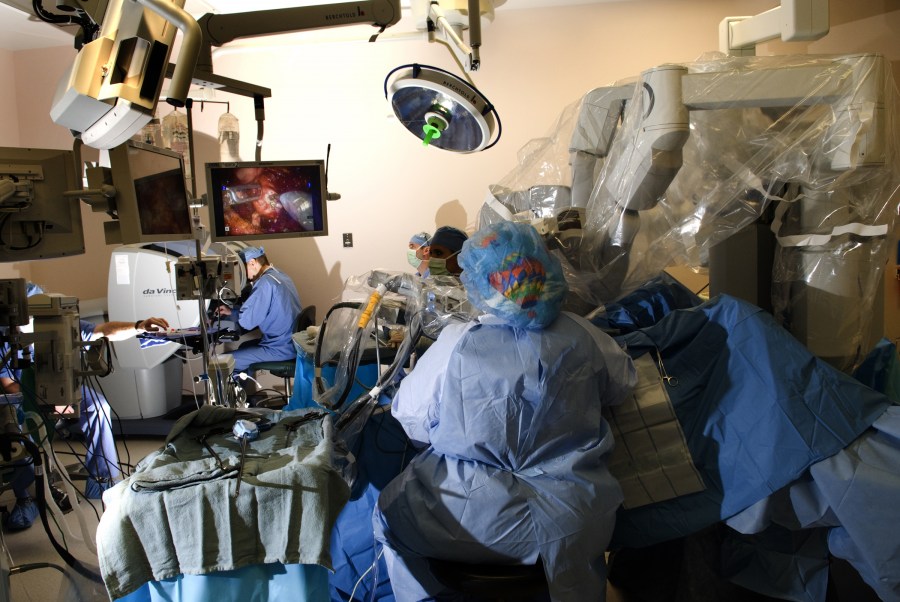
Using the da Vinci Surgical System, Joseph Smith, M.D., far left, controls the robot that performs the surgery. (photo by Susan Urmy)
The da Vinci combines the benefits of minimally invasive laparoscopic surgery with the ease of traditional open surgery. Laparoscopic surgery is often described as operating with chopsticks, but the da Vinci offers remarkable dexterity and delicacy of movements.
“The da Vinci is truly intuitive,” said Willie Melvin, M.D., assistant professor of Surgery. “Operating with the da Vinci is really no different than operating with your hands.”
Melvin performed Tennessee's first robotic gastric bypass surgery last September, and now averages two-to-three robotic procedures per week.
The da Vinci allows Melvin to hand sew the new stomach and bowel connections required of gastric bypass instead of stapling them as is standard in laparoscopy, which reduces scarring and minimizes leaking at the connection.
“Some naysayers say the robot is just a fancy sewing machine. You could reduce it to that, but it's a fancy sewing machine with greater than optimum dexterity and visualization. You can actually see the layers that you are putting together and control the tissue and the suturing better,” he said.
One of the four arms of the da Vinci has a camera with 12x magnification and true binocular vision, giving the surgeons a sense of depth perception. It also has a powerful light source that completely illuminates the surgical field.
The other three arms of the da Vinci have interchangeable tools such as forceps, needles, scissors and scalpels. The surgeon controls two arms at a time, but can use the third for static activities, such as clamping.
The system translates the surgeon's movements, removing tremor and scaling them appropriately.
“The robot is perfect for very exacting, delicate procedures,” said Ted Anderson, M.D., Ph.D., associate professor of Obstetrics and Gynecology and director of the Minimally Invasive Gynecologic Surgery Program.
“With removal of uterine fibroids or infiltrative endometriosis, for example, I do not want to compromise fertility. I may not have the ability to get the correct angles with traditional laparoscopy, and laparotomy means the patient could be in the hospital for a couple of days. With the robot, I can achieve excellent repair and they usually go home the same day.”
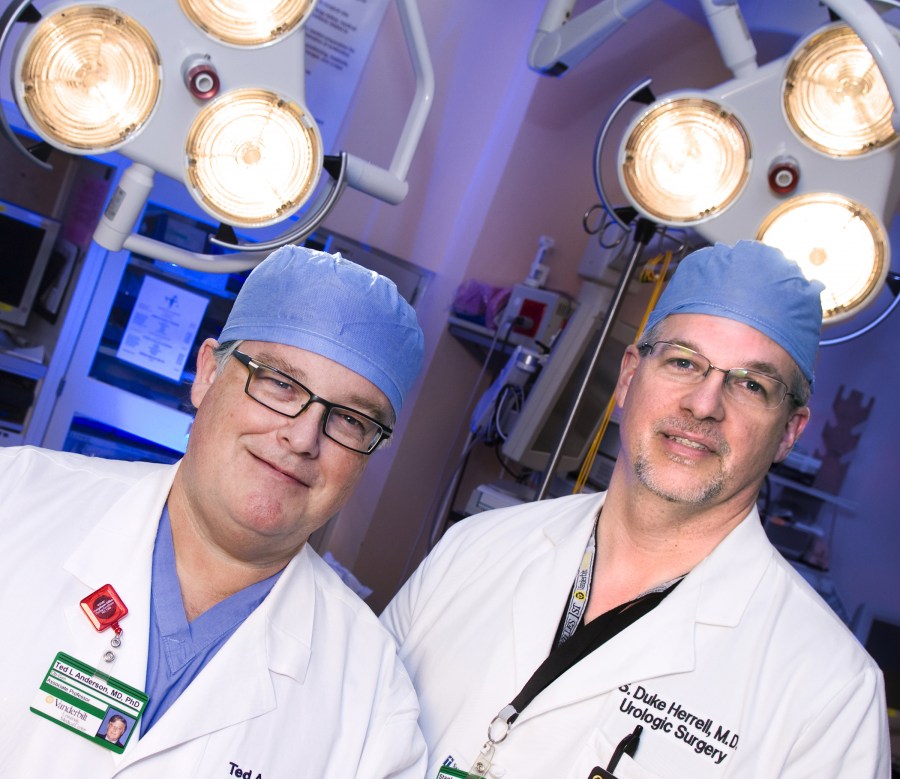
Ted Anderson, M.D., Ph.D., left, and Duke Herrell, M.D., are among the surgeons using the robotic system. (photo by Susan Urmy)
Duke Herrell, M.D., associate professor of Urologic Surgery, is director of Vanderbilt's Robotic Surgery Committee, which is charged with credentialing surgeons to use the da Vinci, administrating the growing robotic surgery enterprise and envisioning future development and acquisition of robotic instruments.
Currently, the Monroe Carell Jr. Children's Hospital at Vanderbilt is considering purchasing a da Vinci. John Brock, M.D., surgeon-in-chief, anticipates using the robot with several services, including General Surgery, Urology and Otolaryngology.
“The use of robotics in children is in its infancy. We need to be one of the leaders in designing the applications for the future,” Brock said.
Earlier this summer, Herrell and John Thomas, M.D., assistant professor of Pediatric Urology, performed what is believed to be Tennessee's first da Vinci procedure on a child.
One area that is proven successful in robotic surgery is radical prostatectomy. Joseph Smith, M.D., chair of the Department of Urologic Surgery, performed Vanderbilt's first robotic surgery in 2003. He has done more than 3,000 prostatectomies since then and says Vanderbilt's volume of this procedure is as much as any hospital in the world.
“There's a peculiar marriage between radical prostatectomy and robot technology that makes that a uniquely well-suited procedure for it,” Smith said. “The radical prostatectomy — being a very precise dissection — requires some difficult suturing and a pure laparoscopic approach is difficult. The robot overcomes those difficulties.”
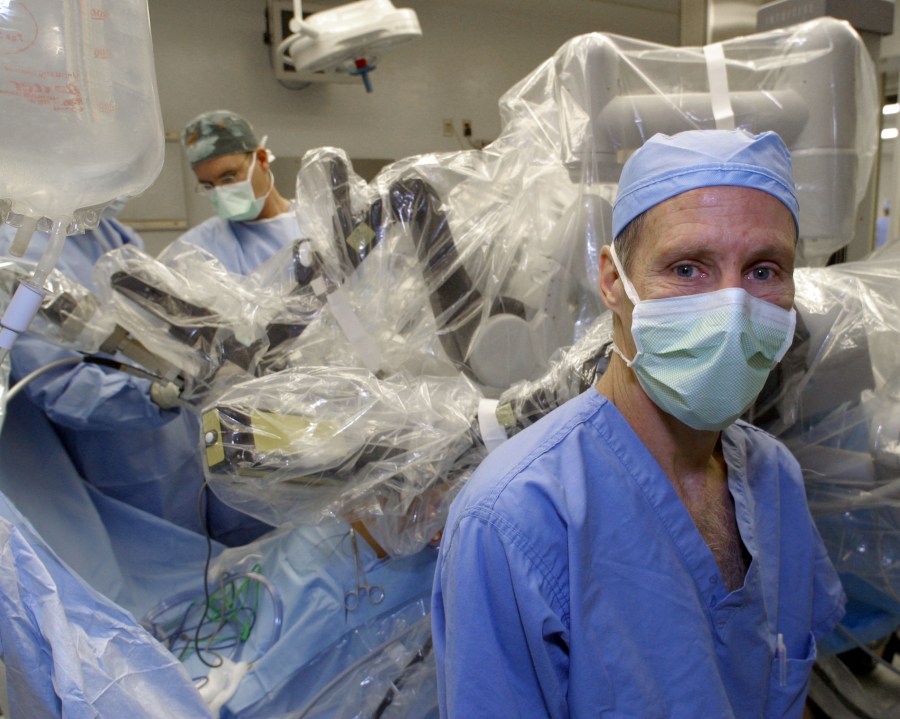
Joseph Smith, M.D., performed Vanderbilt’s first robotic surgery in 2003.
In a prostatectomy with the da Vinci, the surgical margin, measuring how often the cancer is removed completely, is improved.
Ninety-nine percent of patients are discharged the next day, and 99 percent do not require a blood transfusion. Improvement in functional outcomes, like preserving urinary control and erection, have been modest, but newer modifications in technique appear to make a major difference.
This month, James Netterville, M.D., director of Head and Neck Oncologic Surgery, performed Vanderbilt's first robotic transaxillary (through the armpit) resection of the thyroid.
One major advantage of this procedure is the prevention of scarring in patients who form hypertophic scars, but this technique is really the initial building block of many less invasive procedures in Head and Neck surgery.
“For head and neck applications, the current da Vinci, as elegant and advanced as it is, is still a first-generation device compared to the future models. So we're going to press the envelope to do every kind of robotic, minimally invasive surgery in the head and neck trying to advance this technique,” Netterville said.
Current robotic procedures at Vanderbilt include:
• Prostate cancer surgery
• Kidney cancer surgery
• Bladder cancer surgery
• Urinary tract reconstruction
• Incontinence surgery
• Uterine cancer surgery
• Cervical cancer surgery
• Hysterectomy
• Myoectomy
• Sacral colpopexy
• Gastric bypass
• Revisional bariatric surgery
• Revisional hiatal hernia surgery
• Thyroidectomy.
VU a leader in creating next generation of robots
by Leslie Hill
Though the da Vinci Surgical System seems like cutting-edge technology, most surgeons are quick to admit that it a first-generation device — the model T Ford of its kind.
Strong collaborations exist between VUMC surgeons and Vanderbilt University engineers, allowing development of the next generation of surgical technology.
“There are a lot of places interested in capitalizing on robotics, but there aren't a lot of places working to make it better,” said Duke Herrell, M.D., associate professor of Urologic Surgery. “One of the things I love about Vanderbilt is that we have this great undergraduate and graduate campus next door. I can walk right over and be in their lab and talk about new innovations.”
Herrell collaborates closely with Bob Galloway, Ph.D., and Michael Miga, Ph.D., professors in the Department of Biomedical Engineering. Their current focus is image-guided surgery, the premise of which is to easily show the surgeon the tissue structure in the operating field and where instruments are in relation to it.
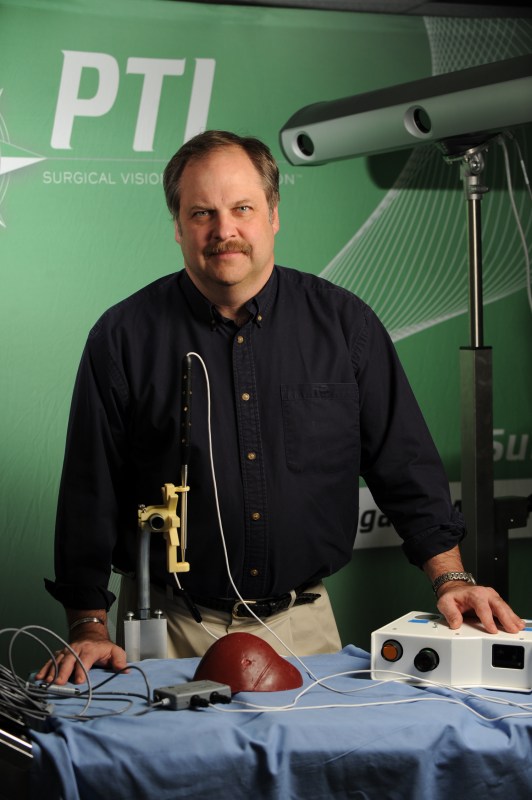
Bob Galloway, Ph.D.
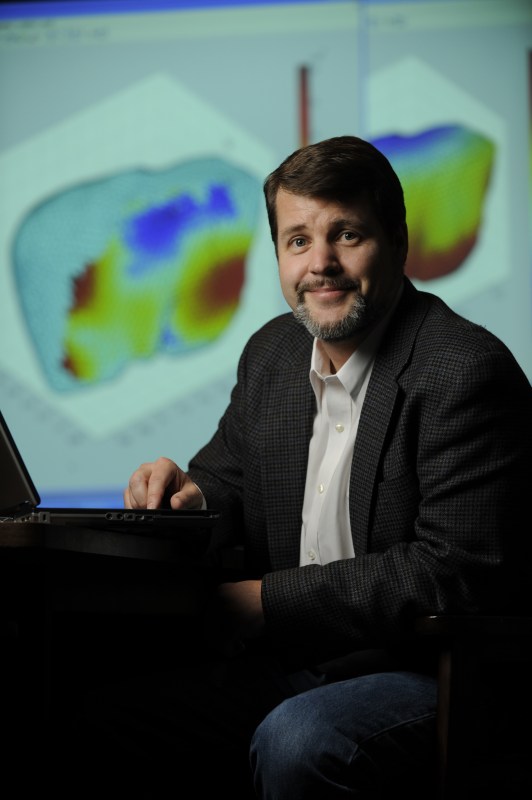
Michael Miga, Ph.D.
Current image-guidance systems use scans that were taken days or weeks before the surgery. As time elapses or the surgeon operates, those scans become more and more inaccurate. Miga develops mathematical models predicting how tissue decays and Galloway incorporates that into the image shown to the surgeon, giving him or her a highly accurate presentation of the tissue in real time.
“Imagine seeing clearly on a screen the three-dimensional kidney, all its vital structures and the tumor you want to remove. As you're operating, you know when you are about to hit a blood vessel or critical nerve,” Herrell said.
The group's work won Best Research Paper at the World Congress of Endourology last year, and they say that the close partnership between engineering and surgery is the key to their success.
“You have to have engineers, who are true innovators and constantly want to change things, teamed with surgeons who understand the real-world task, so that what comes out is something useful,” Galloway said.
An area with major potential for robotic innovation is Neurosurgery because the da Vinci is too large to fit in many areas around the brain.
“We have many orifices, like the nose and mouth, to access the brain, it's just a matter of developing the next technology to get us in there safely and accurately,” said Reid Thompson, M.D., chair of the Department of Neurological Surgery.
Robert Labadie, M.D., Ph.D., associate professor of Otolaryngology and Biomedical Engineering, and Robert Webster III, Ph.D., assistant professor of Mechanical Engineering, head a team developing a truly autonomous robot and recently demonstrated the world's first robotic mastoidectomy on a human cadaver. (Video available at www.vanderbilt.edu/caos.)
Labadie's team has also used robotic technology to develop a minimally invasive approach for cochlear implantation that is under FDA review for clinical implementation.
“A lot of people say we don't really need these robotic innovations. They're expensive and we have good outcomes as it is,” Herrell said. “But I'm not happy with the status quo. I don't think we've figured everything out. We can always be better.”













